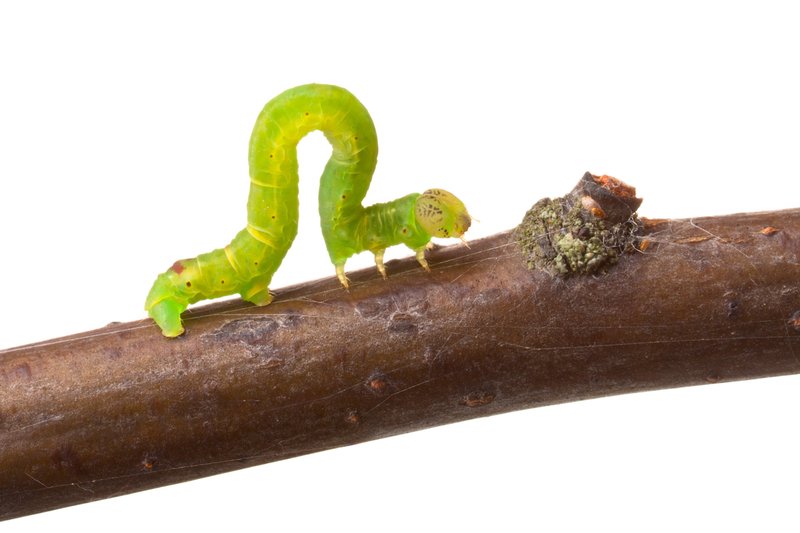
Inchworms may have their favorites, and understanding what draws them to certain tree species can give you insight into their life cycle and feeding habits. Let’s delve into the reasons inchworms might choose to hang out in your backyard or local park and see if there’s any truth to their preferences for certain trees.
What Are Inchworms?
Before we dive into their tree preferences, it’s helpful to know more about inchworms themselves. Essentially, inchworms are the larval stages of moths from the Geometridae family. They are known for their unique way of moving, drawing their bodies up in a loop before extending forward, giving off that classic “inchworm” appearance.
You might find them in gardens, forests, or even urban areas, where they blend into their surroundings. Inchworms are generally green or brown, which allows them to camouflage well among leaves. This camouflage is key to avoiding predators. They also eat leaves, which is crucial for their growth and transformation into adult moths.
Understanding their lifecycle helps explain why they choose specific trees. After all, if you’re a hungry inchworm, you pick the trees that will give you the most nutritious meal.
Do Inchworms Prefer Specific Tree Species?
So, do inchworms have a favorite tree? The short answer is yes! Different species of inchworms are attracted to various trees, primarily based on the type of leaves they prefer to munch on. Just like humans have diverse tastes in food, inchworms are selective eaters.
**Key Factors Influencing Tree Preference:**
– **Leaf Type:** Some inchworm species prefer broadleaf trees, while others might favor needle-bearing conifers. For example, caterpillars like the Eastern Tent Caterpillar are fond of cherry and apple trees.
– **Nutritional Value:** The nutritional composition of the leaves is vital. Inchworms need a diet rich in nutrients to grow, making certain trees more appealing based on the leaves’ quality.
– **Microhabitats:** While it’s not a specific tree species, the environment in which the tree grows—like sunlight availability or moisture level—can influence inchworm attraction.
Popular Trees for Inchworms
Here are some tree species that are commonly favored by inchworms:
- Oak Trees: Many inchworm species thrive on the leaves of oak trees. These sturdy leaves provide ample nutrition and are widespread in many regions.
- Aspen Trees: Known for their fluttering leaves, aspens are also attractive to certain inchworms.
- Pine Trees: Some inchworms enjoy feasting on the needles of pine trees, especially during the larval stage of specific moths.
- Fruit Trees: Apple and cherry trees are particularly enticing because of their tender leaves and fruits.
- Maple Trees: Maples are another favorite, providing a solid source of nourishment.
Each of these tree types offers different benefits, making them popular dining spots for inchworms.
How Inchworms Impact Trees
You might be wondering, what happens when inchworms choose to feast on your trees? Well, their impact can vary. In small numbers, inchworms can do little harm, but when their populations explode, they can cause significant damage.
Inchworms feed on leaves, which can lead to defoliation. If a tree loses too many leaves, it can weaken significantly, making it more susceptible to diseases and pests. Think of it like a person who can’t get enough nutrients; over time, they become weak and unhealthy.
But here’s the flip side: many trees can recover from mild to moderate defoliation. They have evolved to withstand some damage, so don’t panic if you find a few inchworms munching away!
How to Manage Inchworms in Your Garden
If inchworms have taken over your trees and you want to manage their numbers, you have a few options. Here are some practical tips:
– **Manual Removal:** One of the simplest methods is to pick them off by hand. It’s a bit tedious, but it gets the job done without chemical aids.
– **Natural Predators:** Consider attracting birds, such as chickadees or blue jays, to your garden. These birds naturally eat inchworms, helping to keep their numbers low.
– **Insecticidal Soap:** For a more hands-off approach, you might try insecticidal soap. This is an organic option that targets soft-bodied insects like inchworms.
– **Regular Monitoring:** Keeping an eye on your trees can help you catch any inchworm invasions early, making control much easier.
Why Tree Species Matter for Inchworm Populations
The relationship between inchworms and specific tree species is essential to understand, especially if you’re a gardener or a forest manager. Different tree species harbor different kinds of inchworms, which can affect the overall ecosystem.
Additionally, knowing which trees attract inchworms can help in planning for biodiversity in your garden. By planting a variety of trees, you can support a healthier ecosystem while enjoying the beauty of nature.
You might opt for trees that are less appealing to inchworms if you want to minimize their presence or choose those that can tolerate some leaf loss.
Inchworms certainly have their preferences when it comes to trees! They are drawn to certain species due to the leaves’ nutritional value and their unique habits. Understanding which trees attract inchworms can help you manage their populations better and promote a balanced ecosystem in your garden or local area.
While they can be a nuisance when they overpopulate, inchworms play a role in the natural order of things. By respecting their place in nature and managing them wisely, you can create a welcoming environment for both trees and these curious little critters. So next time you see an inchworm, remember: it’s just another piece of the puzzle in our beautiful, complex world.

